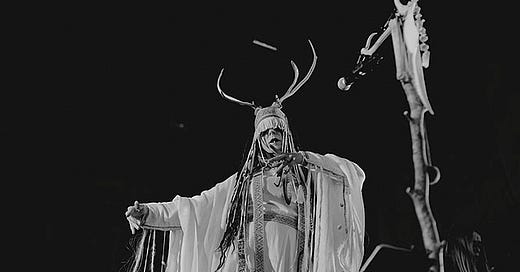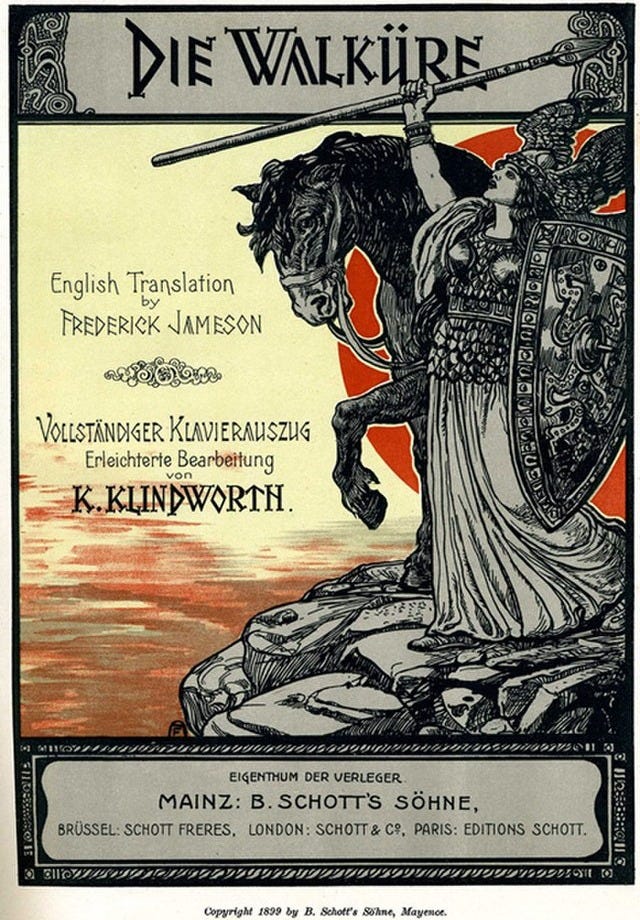When I joined Telegram about a year and a half ago —I was a pagan starved for other pagan interaction. I love the American South, but the shadow of the Baptist church still lays heavily upon it, a too thick blanket in a fitful, sunlit room. Upon joining, I began to notice a certain trend amongst many of the Folkish pagan channels and users: They really, really, did not like Norwegian-German musical group Heilung. This came as a surprise to me; I only discovered Heilung about two or so years ago with the release of their 2022 album Drif, but up until joining Telegram as a user (and long before starting the Thin Hands Coven channel with my two friends,) I had thought of Heilung as universally liked amongst the pagan circles, whether Leftist or more Traditional. But no, it seems not. Why? Well, if I could be allowed to amalgamate the discussions I saw, it would be because many see Heilung as “cringe” or “Larpers;” leftists in their attitude, verging on Satanic with some of their album imagery, inaccurate with their costuming and outward presentation, too eager to mix different European traditions, too New Agey, too universalist. To put it simply —it seems as though the Folkish pagans that I interact with, particularly the Nordic and Germanic ones, find Heilung to not be ideologically pure. Fair enough. In many ways, I agree. However, I would like to put a gentle hand on the shoulder of the reader, and ask them to not throw Heilung and other “Larp” media away so readily, if they will only hear me out.
First, let me get this out of the way: I like a lot of Heilung’s music. Wait! Don’t click away! Let me explain. This is not a Heilung-stan Substack account and this article is absolutely not an apology for Heilung or anything regarding their music and aesthetic. This is not a ranting or a-railing against anyone who doesn’t like Heilung; rather, I wanted to get that out of the way for honesty’s sake. I like much of what Heilung does. I’ve found enjoyment and profundity in their music. But, I too, have my gripes with them. When I accompanied my husband to see them live last autumn on the North American leg of their tour, I truly squirmed in my seat at the opening prayer of their “ritual” (eyeroll).
Remember, that we all are brothers
All people, beasts, trees and stone and wind
We all descend from the one great being
That was always there
Before people lived and named it
Before the first seed sprouted
Huh? What did that even mean? Which great being? Like, God? Which one? Why does this sound like a community college-tier poem a white tiger shirt-wearing middle-aged woman who just found out from her DNA test that she’s 3% Cherokee would write? There was a Puerto-Rican man sitting in the row in front of me. As I stared at the back of his shaved, serene head, I wondered if his Taino ancestors would have called my Cornish ones “brother?”
Somehow, I doubt it.
So yes, I agree. Their aesthetic is often a hodgepodge of different time periods, regions, and traditions. This Guardian article seemed to particularly incense people with the inclusion of Siberian-looking shamanic drums and a snowy tundra chosen for the setting of their photoshoot. But I want to return to that live concert; as I sat and looked around (this took place in a nicer, sit-down concert hall, the type of place that hosts musicals and orchestral shows) I was less interested in the historically inaccurate; their ripped robes, their bare feet and antler headdresses, and I became more fascinated by the people immediately around me. Namely, the amount of people crowded into this hall in the American South, so strangled by Christianity. The hall holds a little over 2000 people, and that night, it was near capacity.
Why?
It’s a difficult question to answer, because to follow one track towards an answer requires you to split off into many others which then split off themselves, but if you’ll allow me to sum up thousands of years in a couple sentences of a silly little Substack article then it’s like this: even as pagans were slaughtered or converted, the fascination, the secret yearning in the West for our pagan past never died. Christian scholars studied pagan philosophers in the Middle Ages and the Renaissance, anthropologists attempted to locate the Aryan homeland in the 1800s, those who studied language began to reconstruct tongues that lay old and forgotten; and even as Europe’s children roved far away in space —to North America, to Australia and South Africa, and in spirit, splintering further and further out into dizzying varieties of Christianity, their ancestral past never left them. The pagan past is not dead, I say, because even those who don’t believe in it act it out in their lives, whether they want to or not, and Europeans and their Diaspora simply love to see the past played out before them. Wagner’s Der Ring des Nibelungen or Ring Cycle, despite the problems plaguing the premiere of its first installment, has been an enduring work on opera stages around the world, the doughty image of Brünnhilde, crowned in glory and fire, too fierce, certainly too proud, for any Christian man to tame, has become a towering and iconic image. Despite the fact that the Legendarium of Tolkien is informed by Christian morality, the other half of its marriage, the pagan half, is a wild, muscled noble man, a pagan king, bringing the great weight of Indo-Europe out of the nightblack waters of time.
And readers, how many iterations of Pagan Europe, historically accurate or not, have graced the screen? From all the various adaptations of the legend of King Arthur, to cult classics like The Wicker Man—while not depicting an accurate pagan past, incorporates pagan imagery throughout—to the surge of recent Viking related media such as Valhalla Rising, History Channel’s Vikings, Robert Eggers’ brutal and beautiful The Northman? And what about all this music? Heilung is only a newcomer to the long established rune folk genre, paved by Norway’s Wardruna, and made possible by such folk-touched groups like Ireland’s Celtic Woman and Enya, the difficult-to-classify Dead Can Dance (England/Australia), and heavy bands such as Bathory (Sweden), Manowar (U.S.A), Amorphis (Finland), Týr (Faeroe Islands), Arkona (Russia), Eluveitie (Switzerland), Amon Amarth (Sweden), Heidevolk (the Netherlands), Turisas (Finland), andd Metsatöll (Estonia), to name only a few, and I would be amiss if I didn’t mention the dozens upon dozens of frenzied black metal bands and artists that rose in Scandinavia in the early 1990s, flinging off the banal Protestant yoke, and torching those churches as they went crazed and howling through the night. There are many musicians, many films, and so many unnumbered and uncountable pagan paintings, sculptures, works of art made by hands, shaking hands and calm hands, all suffused with the same fire of creation. What could all of this mean?

Here is my bold claim: All of this pagan and pagan adjacent art, music, TV programming, and film would not be if there was not a deep, searing thirst for them to be. In other words, these things would not exist if there was not a need in the culture for them to exist. And that’s why a large audience accepts these broken, imperfect representations of our ancestral ways. Even things like all the bizarre modern day haircuts and girlboss warriors of Vikings, the silly horned helmets of Wagner, Tolkien’s melding of Odin with Christ in the figure of Gandalf, and the egregiously anachronistic Botox and filler in Nicole Kidman’s face in the The Northman.

At this point you might be asking, “Huwila, what are you saying? Where is all this going?” What I am saying is that: I don’t see Heilung necessarily as a drag or an impediment to our attempt to rebuild a Folkish, history-honoring faith. That might be a strange statement to read, but what I’m beginning to see in the midst of our division between things that are Folkish and things that are not Folkish—in our attempt to not be the careless, leftist parents that take their kids to Pride parades, we move too closely to the the rigid Protestant father of yesteryear who belted his son for owning a Beatles vinyl.
“So, we should just quit being so stuffy and listen to Heilung? Are you going to stop posting stupid pictures of gay fantasy shirts?” No, and no. No, you should not listen to Heilung, or Wardruna, or Danheim, or Korpiklaani, or any of that stuff if that’s not what you want to do. It is absolutely our duty to engage critically with any media that comes into our homes, particularly if we have children in those homes; particularly media that claims to be pagan. If your pagan children like Heilung, perhaps there’s a discussion to be had about what in their music is accurate to your ancestral practice and what isn’t. And here then, is where I believe our opportunity lies: there is a thirst. Remember that. If your co-worker tells you that they watched Vikings and thought it was incredible, instead of rolling your eyes and thinking “Ugh, that stupid show sucks” (which is true, so you’ll not hear any condemnation from me) why not say something like, “Hey, that’s great. If you’re interested in more accurate sources of Nordic history and the religious beliefs of actual historical Vikings, here are some books and documentaries you can check out.” If your classmate tells you that they just discovered Heilung and think it wonderful, and asks something along the lines of “But hey, aren’t you pagan? Do you listen to pagan music like this?” Why not take a moment, just a moment, to answer and explain why or why not.
It’s time for us to engage with those around us. It’s time for us to begin to move out of our dark, candle-filled closets where we've set up our secret altars; time for us to hold ceremonies, at least sometimes, in places other than the dusky woods with our small hearths and covens. There is a thirst. What do people think of when they hear the word “pagan?” Dark, Satanic rituals performed in the wilderness at midnight? Fat Wiccans with multi-colored hair? TV Vikings in creaking leather? New Age hippies with bare feet and flowing clothes, mixing the traditions of the East and West in their little crystal shops, where bronze, busty statues of the Morrigan sit and collect dust next to gold Buddhas? There is a thirst, remember that, there is a (white?) tiger to ride, there is a bull waiting for its horns to be seized, or, if you like, a Larpy music group waiting for its antlers to be grabbed. Heilung, to me, is not the end of a conversation, but a beginning to one. They are a means to slide tentative fingers into a door that has slowly creaked open. If you truly can’t stand Heilung, well, by Frigg, why are you letting them represent paganism for you? Who is there, Reader, for the father who lost his wife and children in a horrific car accident, for the college-aged girl who has suffered an assault and has fallen pregnant, for the spiritually confused former Christian who feels something stir in them when they hear Heilung’s “Alfadhirhaiti,” and listen to the names of the All-Father, the Father of all Germans being recited? Christians, that’s who. Churches, church-associated organizations and charities, just waiting to place a warm hand on the shoulders of the lost and the uncertain. That hand should be yours. Perhaps those first two scenarios are a little above your emotional and financial ability to deal with. But that last one? The coworker, the friend, the cousin you only see on the holidays that confesses to you the strange stirring in their blood at the sight of people on a screen, however imperfectly depicted, living in the Old Ways, at the sound of a beating, rhythmic runefolk song, who has peered into the light of a cracked open door? There is a thirst, and a yearning for warmth. Don’t slam the door. Let your hand be the warmth, let the great spirit of Arya pass from your skin, warmed by your blood which has dropped down over the unnumbered years by your ancestors that is wild and alive, that is awake—to also awaken theirs.
-Huwila









Brilliant as always. We are on the precipice of seeing a pagan media explosion and I truly believe that, for one reason or another (right, wrong, or indifferent, as I always say), Heilung and similar acts will be remembered as a major catalyst in that. Like you say, everyone can decide what that means for them and their family for themselves, but I think their work is important regardless, on the meta level. They'll one day be listed in the "Factors of..." section of a Wiki page, and getting to experience that as it happens in the presence will be important for us to remember in the future!